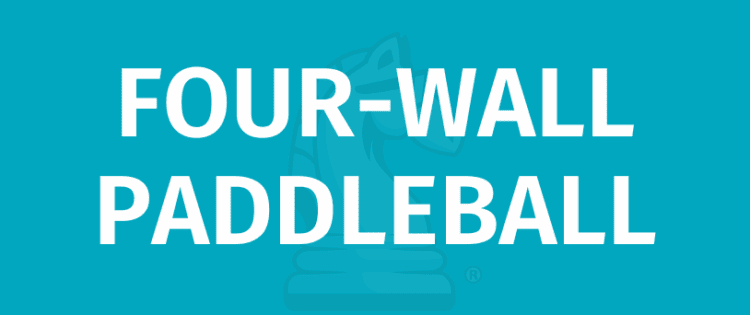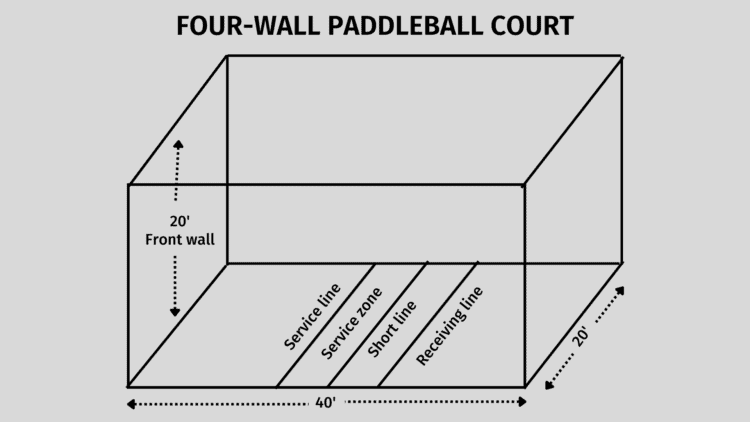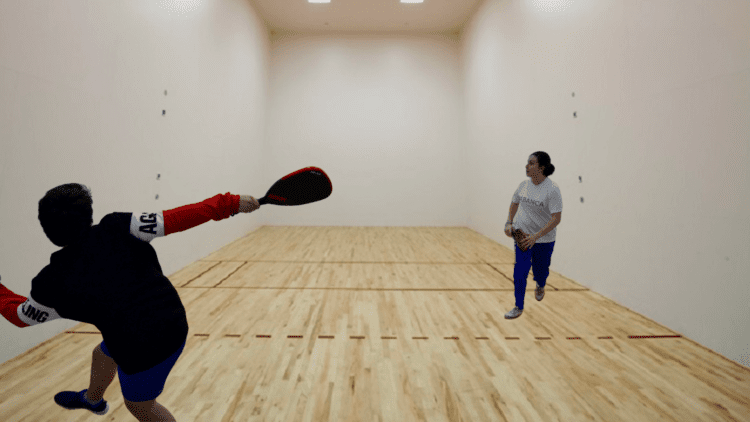
OBJECTIVE OF FOUR-WALL PADDLEBALL: Hit a ball against the “front wall” so that the opposing team cannot return it against the front wall before it bounces twice on the floor.
NUMBER OF PLAYERS: 2 or 4 players
MATERIALS: Paddle, ball
TYPE OF GAME: Sport
AUDIENCE: 8+
OVERVIEW OF FOUR-WALL PADDLEBALL
Four-wall paddleball is an extremely fast-paced sport in which players use a paddle to hit a ball against a wall. This game is similar to racquetball, although the significant difference between the two sports is that four-wall paddleball allows the use of all four surrounding walls, usually including the ceiling. In other words, a player’s head must be on a swivel at all times, as nearly everything is in play!
SETUP

Four-wall paddleball courts should be 40 feet in length and 20 feet in width, the same exact dimensions as a racquetball court. However, as the name implies, four-wall courts must have a back wall and ceiling fit for play.
The court floor should also feature marked lines representing serving and receiving zones.
GAMEPLAY

Four-wall paddleball plays nearly identical to racquetball; players attempt to hit a ball against a designated “front wall” before the ball bounces twice on the floor. Various markings exist on the court to dictate zones from which players are allowed to serve and receive the ball.
Uniquely influenced by the sport’s distinct racket and ball, four-wall paddleball rallies generally last longer than other racket-based sports. This is primarily because the ball moves slightly slower, allowing for more successful volleys between teams.
TEAM SIZES
Four-wall paddleball teams can consist of either one or two players per side. While the rules are seemingly unchanged by the number of players, the combination of long rallies paired with four players on the court at a given time adds a physical aspect to the game that is entirely absent in other racket sports. While contact with other players is not an encouraged aspect of the game, it is unavoidable in many instances and makes for exciting gameplay dynamics.
SCORING
Four-wall paddleball games are played until one team scores 21 points.
In order to score a point, a player must hit the ball against the front wall in a manner that renders the opposing team unable to return the volley against the same front wall before it strikes the ground twice.
DISTINCTIVE RULES
Without its own special rules, four-wall paddleball would simply be racquetball with, well, a fourth wall. For the most part, this is exactly what the sport is; however, one major distinction between the two sports is the ability to use the full court.
In four-wall paddleball, a player can hit a ball against the side walls, back wall, and/or ceiling to get it to contact the front wall. This is a unique rule, as racquetball requires a returned ball to contact the front wall before hitting any side walls.
In the event a player makes avoidable contact with an opponent, a situation termed a “hinder,” the non-offending side is awarded the point for the rally.
END OF GAME
Four-wall paddleball games are played until a team first reaches 21 points. Often, matches are in a best-of-three format, meaning a team must win two games to win the match.
- 30 GAMES TO PLAY OVER TEXT - April 22, 2024
- 20+ FREE PRINTABLE BABY SHOWER GAMES - April 16, 2024
- 20+ College Party Games for the Best Night Ever! - April 2, 2024